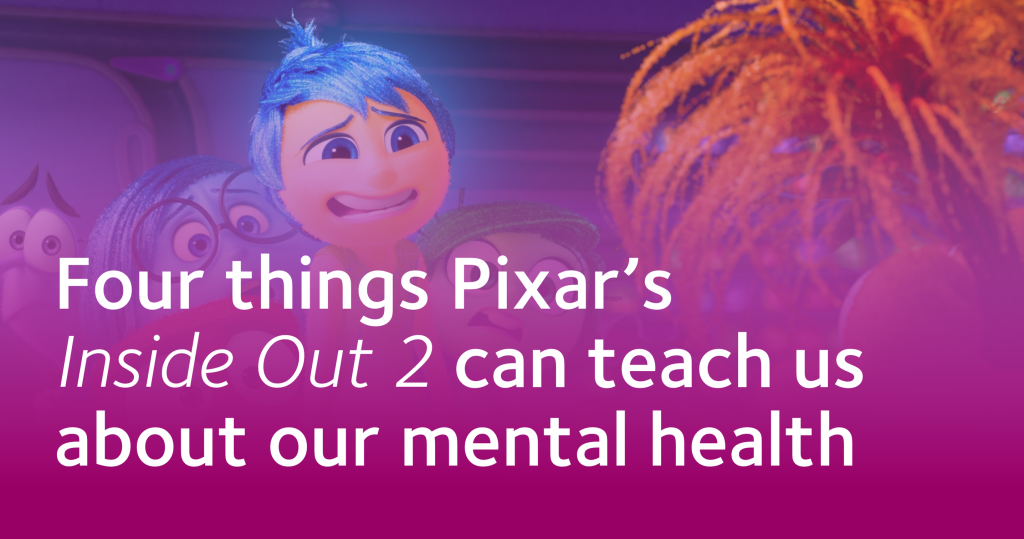
Have you ever wondered what goes on inside your mind? Inside Out 2, the sequel to Pixar’s 2015 hit, is in cinemas now, ready to take you on a journey through the colourful and complex world of our emotions. Here are four things we think the new Pixar film can teach us about our own mental health (please read with caution – this blog post will contain some spoilers!)
Inside Out 2 takes us into Riley’s mind as she experiences significant change. She’s preparing to move from middle school to high school, and learns that her closest friends will not be going to the same school. She’s also entering puberty, dealing with changes in her body, mood, and relationships. So much of Riley’s experience in the film reminded me of the more challenging times in my own teenage years! (Speaking of which – did you know that Action Mental Health run wellbeing programmes in schools to support children and teenagers through changes and challenges? Check out our MensSana service page for more information!)
The thing is, change doesn’t stop when we become adults. It’s a natural, frequently occurring part of being human. And change, no matter if it’s positive or negative, can significantly impact our mental health. Transitions such as moving home, starting a new job, or going through changes in relationships can shift our normal rhythms and sense of stability, leaving us feeling unsure or uncertain.
It’s vital that we take extra care of ourselves during times of change. Maintaining some sort of routine can be really helpful, offering a sense of ‘normal’ and predictability. Practice self-care – and I don’t mean just treats and bubble baths (although these are great, too), but activities that help you feel calm, in control, and balanced. Talk about how you’re feeling with someone you trust. Get outdoors if you can, and move your body. Eat nourishing food, drink water, and get enough sleep.
The first Inside Out film showed us that while we often see ‘sadness’ as a negative emotion to be avoided, it actually serves a very important purpose. Inside Out 2 reinforces the powerful message that no emotions are inherently ‘bad.’
In Inside Out 2, we meet Anxiety, whose drive is to keep Riley safe. We all need a healthy level of anxiety to protect us from potential threats and prepare us for challenging situations. Which leads to my next point…
In the film, Anxiety takes the reins. She banishes the original gang of emotions from the first movie to the back of Riley’s mind, becoming controlling and domineering. Anxiety came in to protect and prepare Riley, but instead, it became overwhelming and overshadowing, dominating every thought. This isn’t healthy.
Anxiety can look different for different people, and sometimes it can be hard to spot right away that it’s becoming overwhelming. For Riley, Anxiety manifested in worry and fear, racing thoughts, and, towards the end, a pounding heartbeat, blurred vision, and shortness of breath. However, for others, anxiety might look like restlessness, fatigue, or difficulty concentrating. Some people might feel more irritable, while others may feel the need to withdraw from social settings or activities.
It’s important to know how to spot these signs in ourselves and others. In Riley’s case, it was her two best friends who noticed she was having a difficult time – a great reminder for us to keep an eye on those around us and reach out if we feel they might need support.
The plot of Inside Out 2 revolves around a mission to restore Riley’s ‘sense of self.’ At the beginning of the film, Joy shows us Riley’s ‘belief system,’ essentially a set of values guiding Riley’s life, made up of a carefully curated collection of Joy’s favorite memories. Summed up in a sentence, Riley believes that she is a good person.
Anxiety disrupts this belief system. She discards it, replacing the positive memories with moments dominated by worry and apprehension. Over time, a new sense of self is built – one telling Riley she’s not good enough.
The film poignantly shows how easy it is to mistake how we feel for who we are. It reminded me of something I saw few years ago, a quote from local poet Padraig O’Tuama made the rounds on social media. He points out that in the Irish language, when expressing emotion, you don’t say ‘I am sad.’ The direct translation is ‘sadness is on me.’ This simple linguistic detail can hugely transform our mindset. We’re feeling sadness right now, but it’s not who we are. We’re experiencing anxiety at the moment, but it’s not our whole identity.
At the end of the film, a new belief system is formed, based on all of Riley’s memories – the joyful ones, the anxious ones, the sad ones, the fearful ones, the angry ones. Riley’s new sense of self can no longer be summed up in just a sentence. It becomes fluid, nuanced, and complex. It’s multi-coloured, changing in shape, size, and volume. There are wonderful things, and there are hard things. It’s a much more realistic depiction of the human experience.
Inside Out 2 reminds us that while our emotions can be intense sometimes, they are just one part of our experience. They are not who we are at our core.
As Inside Out 2 beautifully shows, navigating our emotions and mental health can be challenging, especially during times of change. It’s a friendly reminder to take care of ourselves and support those around us. For lots of us, it will be a really enjoyable watch – but please do keep in mind that the themes might hit close to home if you have personal experience of anxiety. And if, after watching the film or reading this blog, you are feeling concerned or overwhelmed by your own thoughts or feelings, please reach out to a friend or family member, or a professional such as your doctor. You are not alone!